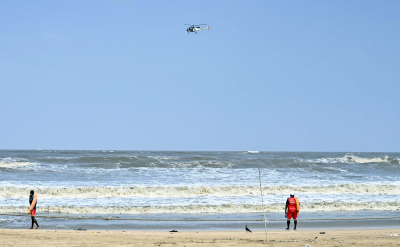Mumbai: Maharashtra is considered blessed with a 720-km coastline, which may turn out to be a curse in the long run with the rapid ongoing climate change scenario.
The state’s scenic coast — comprising districts of Palghar, Thane, Mumbai, Raigad, Ratnagiri and Sindhudurg — is dotted with around 36 creeks, 48 big and small ports, scores of important forts and national monuments, other attractions, sea links, coastal highways, over 4,000 hotels, resorts, guest houses and local lodging and boarding services catering from the five-star high-fliers to the shoe-string budget tourists.
It is also home to the country’s bustling commercial capital and thousands of fishing villages, a UNESCO World Heritage site, the Elephanta Island, plus the upcoming Jaitapur Nuclear Power Plant and Nanar Oil Refinery, both billed as the biggest in the world and around 1,100 big and small beaches, including some of the most picturesque ones in the country.
However, as nature changes its ‘cool temperament’, all of this could face a grave risk, as per an ongoing research study being conducted by Sukanya Khese, 27, ICSSR Doctoral Fellow, with the S.P. College of the Savitribai Phule Pune University (SPPU), guided by Dr Rahul Todmal.
Focussing on the impact of climatic change with specific reference to the tourist sector in the near-term (2025-2060) and long-term up to 2100, Khese used the Tourism Climate Index to evaluate the repercussions in coastal Maharashtra, and considering the likely differing scenarios pertaining to failure or success in controlling emissions.
“This considers the monthly mean temperatures, rainfall, duration of sunshine, humidity, wind-speed climatic variables which affect the tourism season, the pleasant ambience of the destination and the tourist preferences as well,” Khese told IANS.
In recent decades, the tourism industry has been partially responsible for Green House Gases (GHG) accounting for about 14 per cent of all emissions, and the changing climate implies a significant effect on the tourism business, the demand, market and services.
Using various parameters, Khese’s study has cautioned that the overall negative effect of climate change, coupled with GHG emissions, unplanned tourism activities, increasing pollution and degradation of natural resources, with a possible ugly hit on the flow of tourists to the coastal areas of the state.
Spelling a warning for Mumbai — the state’s single-biggest tourist destination, as per Department of Tourism data — Raigad and Ratnagiri, available data indicates there could be adverse changes in rainfall and temperature that could hamper the tourist economy.
Furthermore, Mumbai and the Mumbai Metropolitan Region (MMR), are prone to the ‘urban heat island’ effect due to future warming, which may also affect other major cities in the country, owing to rising temperature and rainfall during summer and monsoon respectively, Khese pointed out.
“As per estimates, heavy rainfall events along with a temperature increase by 1 degree C to 3 degrees C is likely to hit coastal tourism, which usually peaks in winter – from October to February months. Due to the projected changes signalling warm winters, tourism could drastically decline in the main season itself,” Khese explained.
In fact, in the entire Konkan region, experts say that Mumbai and Sindhudurg – ranked the coastal tourist mecca, may face huge deterioration in climatic favorability for tourism in the second half of this century, particularly post-2060.
Khese said that based on the findings thrown up by her study, the concerned government departments, tourism authorities and allied stakeholders as well as environmentalists should consider formulating policies and long-term plans to combat the potential crises looming over coastal tourism by the turn of the century, unless emissions are controlled.
Nevertheless, the government is optimistic about the future and forging ahead to create tourism infrastructure, developing Marinas at sites like Mandwa, Belapur, Vasai, Malad and Dharamtar in the MMR, with promises of speedboats, yachts, water sports, jet-skis, scuba-diving, undersea tours, a swank cruise terminal, and developing the Sindhudurg Coastal Circuit, etc to lure big bucks investments and tourists.
(Quaid Najmi can be contacted at q.najmi@ians.in)
–IANS


Comments are closed.